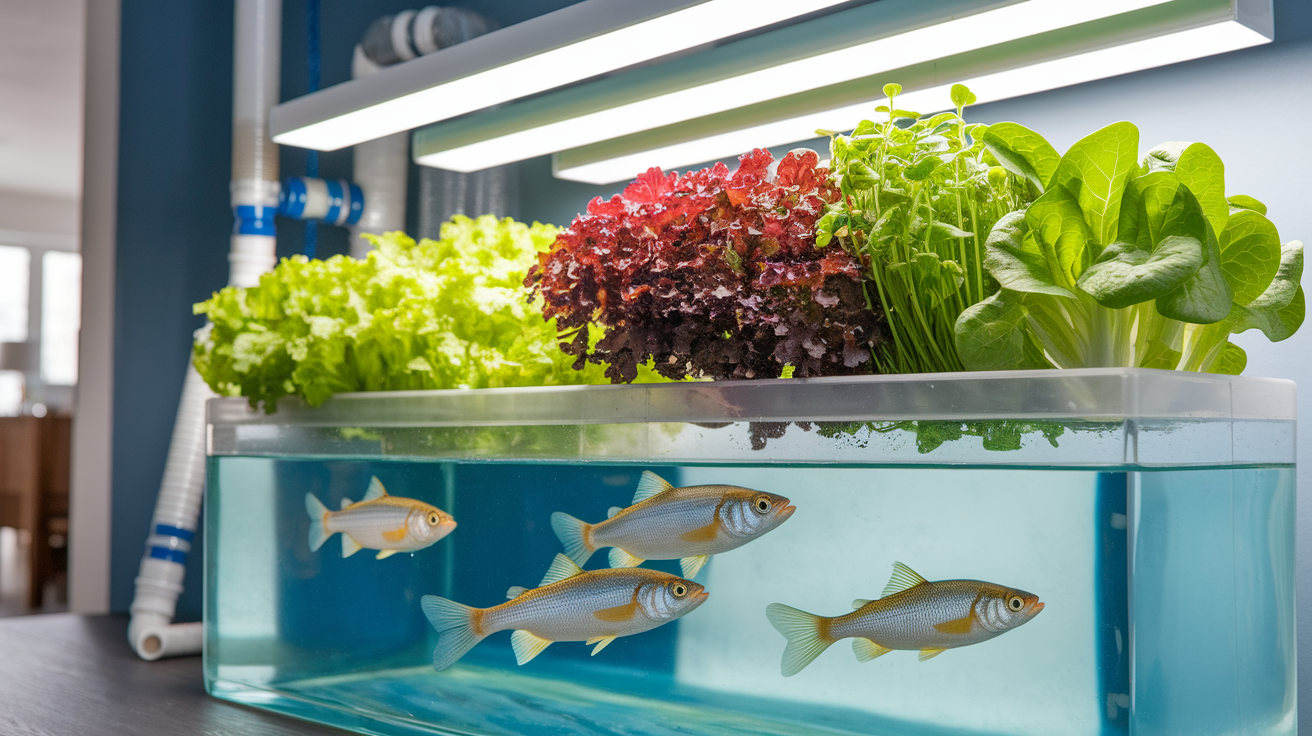Have you ever watched fish swimming in your tank and wished they could do more than just look pretty? Your aquarium can become a mini food factory with almost no extra work. The secret lies in aquaponics – where fish waste feeds plants, and plants clean water for fish.
Imagine fresh basil, lettuce, and herbs growing right above your fish tank. No soil needed. No weeding. No daily watering.
This system saves water, space, and time while giving you organic herbs for your kitchen. With just a few simple parts from any hardware store, you can build this setup in an afternoon.
Ready to turn your regular fish tank into a two-in-one food system? Let’s build your first aquaponics setup today.
Benefits of a DIY Aquaponics Fish Tank
-
Sustainable Food Production at Home
A DIY aquaponics fish tank allows you to grow both fish and plants in a self-sustaining ecosystem. This method reduces the need for chemical fertilizers and supports sustainable food practices, helping you become more self-reliant. -
Less Water Usage Compared to Traditional Gardening
Aquaponics uses a closed-loop water system, which minimizes water waste. The water in the tank is continuously recycled, making it much more efficient than traditional soil-based gardening, where water often evaporates or drains away. -
Space-Efficient for Urban Living
Aquaponics systems are compact and perfect for small spaces like apartments or urban homes. You can grow a variety of plants and fish in a limited area, making it an ideal solution for city dwellers looking to have a garden at home. -
Growing Organic Fish and Plants Together
With aquaponics, you can raise fish and grow plants organically. The fish waste provides nutrients for the plants, while the plants naturally filter and clean the water for the fish, creating a harmonious and eco-friendly system.
These benefits make DIY aquaponics an attractive option for sustainable living, saving resources, and growing your own food at home.
Choosing the Right Fish for Your Aquaponics Tank
When selecting fish for your aquaponics tank, it’s important to choose species that thrive in the system’s unique environment. Some of the best fish for aquaponics include:
-
Tilapia: A popular choice due to its resilience and fast growth, making it ideal for beginners.
-
Goldfish: Easy to care for and perfect for smaller systems.
-
Trout: Suitable for cooler climates, offering a faster growth rate in colder water.
-
Catfish: Hardy and adaptable, making them a great option for larger systems.
Ideal Fish Tank Size and Condition
The tank size depends on the number and size of fish. Generally, a 50-100 gallon tank is suitable for smaller systems, while larger tanks are needed for bigger fish populations.
Water temperature, pH levels, and dissolved oxygen should be monitored regularly. For tilapia, keep the water temperature between 75-85°F (24-29°C), with a pH range of 6.8-7.5.
Step-by-Step Guide to Building Your DIY Aquaponics Tank
This guide will show you how to set up a simple system that works with your existing aquarium. You’ll learn about water flow, plant placement, and how to keep both fish and plants happy.
Must-Have Items for an Aquaponics Fish Tank
| Item | Purpose |
|---|---|
| Existing freshwater aquarium | Base for your aquaponics system |
| 90mm (4-inch) PVC pipe with end caps | Creates the plant growing channel |
| Hole saw drill bit | For making plant pot holes in the PVC pipe |
| Small water pump | Moves water from tank to growing channel |
| Plant net pots | Holds plants in the system |
| Expanded clay pebbles, rockwool, or coco peat | Growing medium for plants |
| Plant grow light | Provides energy for plant growth |
| Timer for the light | Ensures consistent light cycles |
| Water testing kit | Monitors water quality and nutrient levels |
Step 1: Understand Your Filtration System
Every aquaponic system needs proper filtration to work well. Mechanical filtration removes solid waste and dirt from your tank water. Biological filtration uses helpful bacteria to change fish waste into plant food.
The first type of bacteria changes ammonia to nitrite. The second type changes nitrite to nitrate. Your plants will use this nitrate as their food source. Both types of filtration must work together in your system.
Step 2: Prepare Your PVC Pipe
Start with a 90mm PVC pipe and cap both ends securely. Mark spots on top where you plan to place your plants. Use a hole saw to drill these holes, making sure they fit your net pots well.
Drill a small hole at one end of the pipe for water to enter. Make another small hole at the opposite end for water to exit. This creates what experts call a nutrient film technique system.
Step 3: Set Up the Water Flow
Place your prepared PVC pipe carefully on top of the aquarium. Make sure it sits firmly and won’t move around. Connect a small water pump from inside your tank to the inlet hole of your pipe.
Set the pump to its lowest speed setting at first. Test the flow to ensure water moves through the pipe slowly. You want just enough water to wet the plant roots with a thin film.
Step 4: Add Your Plants
Select small plants that grow well in water, such as basil, spinach, or other herbs. Take your seedlings and place them in net pots with your chosen growing medium. Expanded clay works well, as do rockwool or coco peat.
Gently insert these prepared net pots into the holes you drilled in the PVC pipe. Check that the plant roots reach down to touch the water flowing below.
Step 5: Set Up Proper Lighting
Mount a grow light above your system to provide plants with needed energy. Set a timer to give your plants between 12 and 16 hours of light each day. Position the light so all plants receive equal amounts of light.
Keep in mind that this extra light may cause some algae growth in your tank. This is normal and can be managed with regular cleaning.
Step 6: Monitor and Maintain
Check your water quality weekly with a test kit. You want nitrate levels around 20 parts per million for good plant growth. Clean your mechanical filters each week to remove built-up waste.
Watch the water flow to make sure plant roots aren’t blocking it. Wipe algae from the glass during your weekly tank care. Add fresh water as needed to replace what evaporates from the system.
Important Tips
- The number of plants you can grow depends on your nitrate levels
- Don’t overload your tank top – nutrient film technique is lighter than grow beds
- Regular aquariums aren’t designed to hold heavy grow beds
- Start with small herbs rather than large plants
- Don’t put tomatoes in this type of system
- Avoid using pool noodles as a growing medium as they may contain harmful substances
Video Tutorial
Refer to the video by Candy, The Aquaponics Lady for a complete visual tutorial:
How to Choose Plants Based on Your Tank Size and Setup
-
Tank Size and Space Requirements
The size of your tank will influence the types of plants you can grow. Smaller tanks (under 20 gallons) may be more suited to leafy greens and herbs that have compact root systems. Larger tanks (over 50 gallons) can support bigger plants, such as tomatoes, cucumbers, and strawberries, which require more space to grow. -
Water Quality and Plant Needs
Different plants have different nutrient needs. While leafy greens like lettuce and herbs require less nutrient-rich water, fruiting plants like tomatoes and cucumbers need more. Ensure that the water in your tank is suitable for the type of plants you want to grow. Plants that require higher nutrient levels may need more frequent water changes or supplemental feed. -
Light Requirements
Some plants, such as leafy greens, can thrive in low light conditions, making them ideal for setups with limited natural sunlight. However, fruiting plants like tomatoes or cucumbers require higher amounts of light, which means you may need to install grow lights if your system is indoors or lacks sufficient natural light. -
Climate and Temperature
Consider the climate and temperature of your environment. Warm-weather plants like tomatoes and cucumbers thrive in temperatures above 70°F, while cooler-weather plants such as lettuce, spinach, and kale prefer lower temperatures (55°F-65°F).
Maintaining Your DIY Aquaponics Fish Tank
Keeping your aquaponics system healthy needs regular care. Follow simple schedule of daily checks, weekly tests, and monthly cleaning to ensure both fish and plants thrive. With proper maintenance, your indoor ecosystem will provide fresh herbs and clean water for months to come.
1. Daily Maintenance
Check water flow in your system each day. Make sure it moves smoothly through the pipe. Look at your fish for signs of stress or illness. Feed fish the right amount – not too much or too little. Remove any fallen leaves from the water.
2. Weekly Tasks
Test water quality once a week. Check pH, ammonia, nitrite, and nitrate levels. Clean any algae from the glass sides. Inspect all equipment like pumps and filters. Prune plants as needed to control size and shape. Harvest ready plants and add new ones.
3. Monthly Maintenance
Clean the pump to remove any built-up waste. Check all tubes and pipes for clogs. Test and adjust the light position if plants have grown taller. Examine roots for health and trim if needed. Deep clean filters but save some old material to keep good bacteria.
4. Seasonal Care
Change light schedules with seasons if using natural light. Adjust water temperature as needed for fish comfort. Replace any worn parts before they fail. Consider adding more growing space if your system works well. Keep records of what grows best in different seasons.
Conclusion
So what makes this DIY aquaponics project worth your time? By turning your ordinary fish tank into a small ecosystem, you’ve created something special. Your fish waste now feeds plants instead of being thrown away. You get fresh herbs without soil, pesticides, or much space.
This setup teaches us about natural cycles while giving us food. Not bad for some PVC pipe and a few simple parts!
What’s next? Start small with just two or three herb plants. As you learn how your system works, you can try new plant varieties. Share your extra harvests with friends and family.
Want to learn more? Join online aquaponics groups where hobbyists share their setups. Your small tank today might inspire bigger growing systems tomorrow.
Happy growing!
Frequently Asked Questions
Can I Use My Fish Tank for Aquaponics?
Yes, you can use an existing fish tank for aquaponics, as long as it’s large enough to accommodate both fish and plants.
What Kills Fish in Aquaponics?
Fish can be killed by poor water quality, high ammonia or nitrite levels, improper pH, overfeeding, or temperature fluctuations.
What Size Tank Is Best for Aquaponics?
A tank size of at least 50 gallons is recommended for beginners, providing enough space for both fish and plants to thrive
















